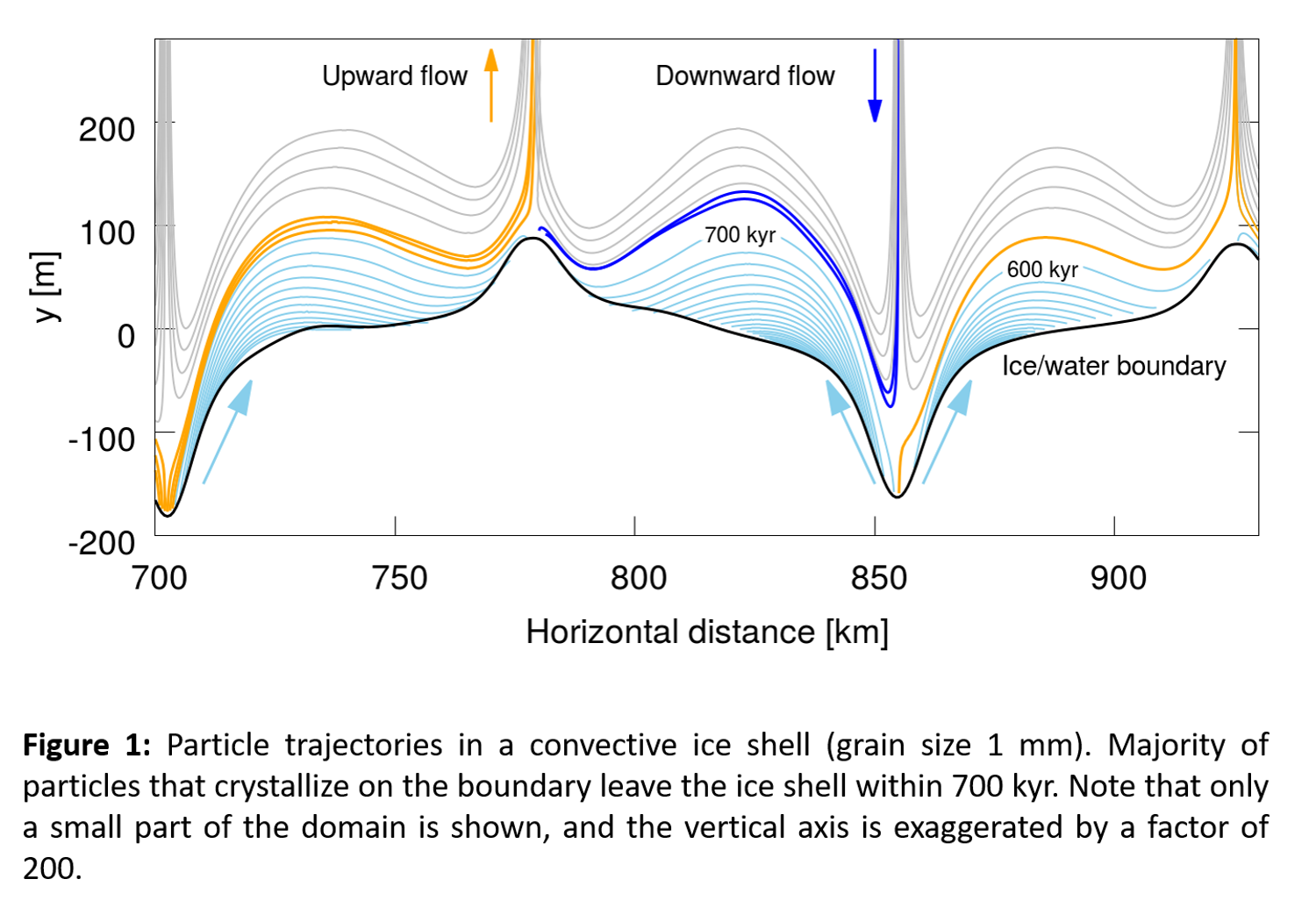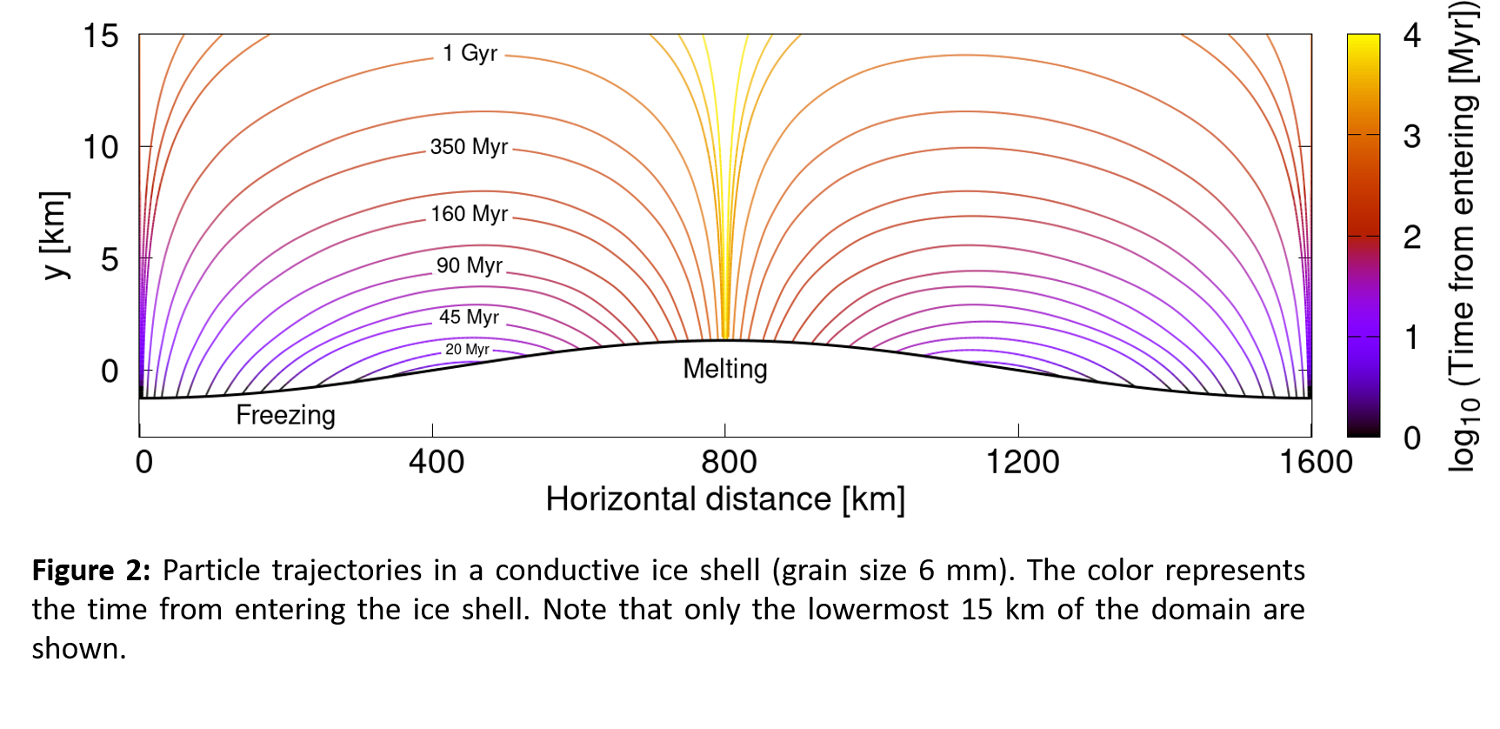Effect of ice-water phase change on the material transport between ice shell and subsurface ocean on icy moons of Jupiter and Saturn
- Charles University, Faculty of Mathematics and Physics, Department of Geophysics, Czech Republic (kihoulou@karel.troja.mff.cuni.cz)
INTRODUCTION
Material transport between the ice shell and the deep interior has recently received some attention since many Jovian and Saturnian icy moons, as well as some Kuiper Belt objects, are believed to harbor global subsurface oceans. Evidence in the form of volatile compounds indicates the existence of mechanisms that transport material from the ocean to the surface (for review, see [1]). The proposed mechanisms suggest either direct exchange due to shell damage (e.g., rupture due to tidal forces, break-through after an impact) in the case of thin shells or indirect transport by subsolidus convection in the case of thicker shells. However, the latter mechanism still needs to be accompanied by an additional shell disruption (e.g., large-scale tectonics or melt-induced collapse), since convecting ice shells are likely to have a stagnant conductive lid, preventing the upwelling material from reaching the surface [1,2].
Several studies have addressed the indirect transport of volatiles in ice [e.g., 2,3], including melt transport in high-pressure ice [4]. Here, we focus on the exchange between the outer ice shell and the ocean, triggered by a discontinuity in heat flux at the ice-water boundary [5]. The heat flux discontinuity, accompanied by melting and freezing, can result from many factors, e.g., uneven surface insolation or albedo, circulation of the ocean, tidal heating, or other temperature variations within the shell. The efficiency of material transport then depends on the mode of heat transfer within the shell because convective flow can carry the material into shallow depths of the ice shell.
METHOD
In this study, we investigate the particle trajectories in the ice shell for two modes of heat transfer – conduction and convection. In the case of conduction (diffusion creep with a grain size of 6 mm), we induce the ice-water boundary shape by a cosine-shaped variation in the heat flux coming from the ocean, resulting in melting in the middle of the domain and freezing on the sides. In the case of convection (grain size 1 mm), we do not impose any variation in the heat flux since they result naturally from convective upwellings and downwellings inside the ice shell.
The evolution of the ice-water boundary is determined by two factors. First, by the velocity of ice flow, v, obtained by solving the equations of thermal convection in the Boussinesq approximation
and, second, by the velocity of the phase change
proportional to the heat flux jump (qi - qw) at the ice-water boundary [5]. As these two factors compete with each other, the shape of the boundary will remain steady once they balance each other (u = -v). We solve the above equations by the finite element method in a rectangular domain of thickness 100 km and aspect ratio 16. We use a free surface boundary condition and temperature of 90 K on the top boundary, and hydrostatic pressure and temperature of 265 K on the bottom boundary. Considering that the ice deforms by diffusion creep, the viscosity only depends on temperature and grain size.
RESULTS
Figure 1 shows the trajectories of material particles near the ice-water interface for a convective case. The light blue lines represent particles entering and leaving the ice shell without rising higher than 200 m above the ice-water boundary. The orange lines represent particles coming from the ocean into the shallow depths of the ice shell, while the dark blue lines represent particles coming in the opposite direction. Finally, the gray lines represent particles trapped within the convection cell, unable to escape. Note that particles enter the shell beneath the downwelling and leave the shell under the plume (in the opposite way than one would expect from models without phase transition), corresponding to regions of freezing and melting maxima, respectively.

Figure 2 shows the trajectories of material particles near the ice-water interface for a conductive case. The color represents the time from entering the ice shell. We observe that only particles that enter the shell at the freezing maxima can rise into shallow depths. However, this process can take up to billions of years, which makes the material exchange in the conductive shell rather inefficient.

CONCLUSIONS
Our preliminary results show that the heat flux variation at the ice-water boundary is necessary to trigger material exchange between the ocean and the ice shell. Irrespective of the heat transfer regime, most of the material crystallizing on the ice-water boundary does not penetrate into shallow depths of the shell and returns to the ocean, making the material exchange inefficient. Furthermore, our results suggest that material in shallow depths of conductive shells might not be recycled on the time scale of the Solar System age.
Acknowledgements
M.K. acknowledges the support from the Czech Science Foundation through project No. 22-20388S and from the Charles University project 115-009/260581.
References
[1] Soderlund, Kalousová, Buffo et al., 2020, Space Sci. Rev., 216, 80.
[2] Kalousová and Sotin, 2020a, Geophys. Res. Lett., 47, e2020GL087481.
[3] Howell and Pappalardo, 2018, Geophys. Res. Lett, 45, 4701–4709
[4] Kalousová and Sotin, 2020b, Earth Planet. Sci. Lett., 545, 116416.
[5] Kvorka et al., 2018, Icarus, 310, 149–164.
How to cite: Kihoulou, M. and Čadek, O.: Effect of ice-water phase change on the material transport between ice shell and subsurface ocean on icy moons of Jupiter and Saturn , Europlanet Science Congress 2022, Granada, Spain, 18–23 Sep 2022, EPSC2022-967, https://doi.org/10.5194/epsc2022-967, 2022.

